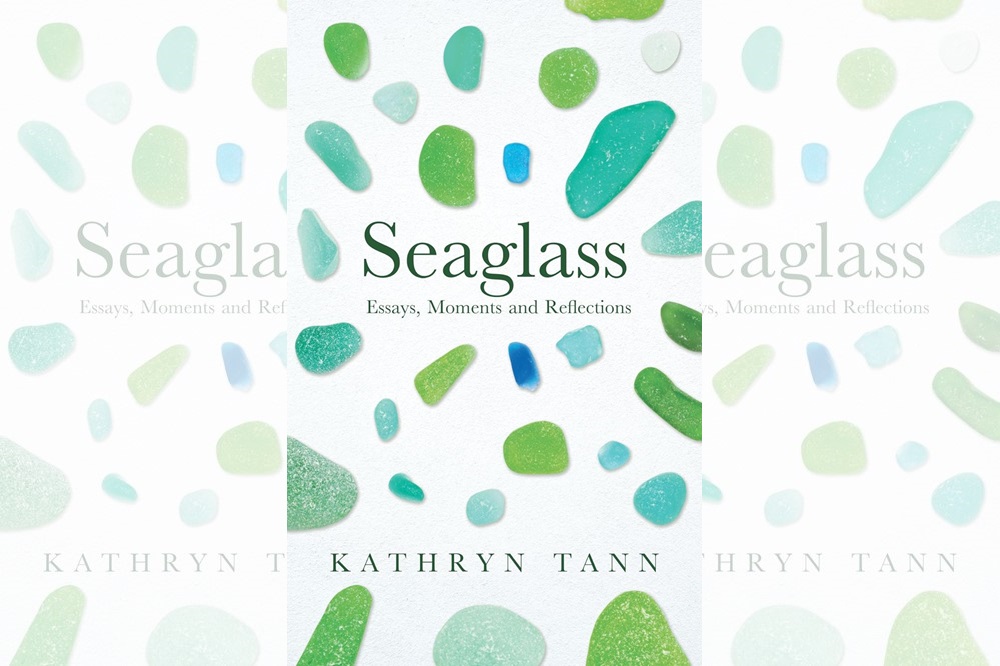Book review: Seaglass: Essays, Moments and Reflections by Kathryn Tann

Lottie Williams
‘I am a library of things. I am made of places and of other people’, writes Kathryn Tann in her debut essay collection ‘Seaglass’ which features stories and reflections from her life in a sort of ‘coming of age’ nature-memoir, but with more maturity and clarity than this popular phrase may otherwise suggest. In between each essay she has included the most beautiful vignettes, including ‘St. Govan’s Head, Bosherston. 5.10p.m.’ and ‘Rhwddolion Valley, Eryri. 1.37 p.m.’, encapsulating these moments and preserving them on paper.
Like her actual collection of glass pebbles collected from shorelines and kept in the stained glass window of a jar, each piece of writing shines with a variety of colours, shapes and locations. Tann writes that, ‘places are not separate from people – not on an island like ours. Places are a collection of stories’. And so the reader is guided from Penarth to Pembrokeshire, Manchester to Durham, York to Ontario. It is within these spaces where Tann crosses her story lines through thoughts of time and distance, understanding and reconciliation, and family is the gravy (she makes a good one) which pulls them all together.
Paying attention
Tann’s relationship with her dad is one of warmth and support. His presence is there throughout and he teaches her the importance of paying attention to a beauty found within the ugly noise of contemporary life: the birds and nettles reclaiming small patches of post industrial land and inner city ring roads; of swans nesting in plastic scraps by mud-sucked trolleys; how a hawthorn tree and a barbed fence are a ‘weave of wire and branch’. He widens her lens, and understands her love for wild swimming.Together they venture out to regular spots along the coast, sometimes braving the Herculanean winds and waves as they assess the safety of climbing along cliff ledges and hurling themselves into the sea.
Acne
The theme of connection continues with Tann’s relationship to the concept of self. For many years she battled with the complexities of facial acne, choosing to hide her face under layers of perfectly presented make up. The rituals of applying foundation mirrored the rituals of searching for seaglass, but only one of these acts was gifted the warmth of sunlight. In sacrifice and shame she turned from swimming, its threat of exposing her true self too much to bear, and her long journey back to the water (a fist pump reader moment) is relatable for anyone facing challenges to freely do what they love.
Swimming
Tann writes from the heart about swimming. From wild seas and mountainous plunge pools, to Covid regulation leisure centres, privately owned reservoirs and polluted rivers, she continues to highlight vulnerability, questioning the right for humans to swim, and for the land to have a voice.
She observes the wildfires of the Yorkshire Moors, where ‘the ash glitters like coal dust in the high sun’. She discovers how the unnatural acidity of the moorland is a curse from the Industrial Revolution. She learns the importance of sphagnum moss and rewetting the peat, and ‘how deeply we can hurt our surroundings’. She considers the ruler straight Ouse in York and how it easily spills over the banks, creating islands of bins and benches. She looks down from the float of a hot air balloon to the grid lock of fields below. She questions how ‘we give living land boundaries and expect it to stay within the lines’, and she expects the reader to consider all of these thoughts too. Tann has learnt that nothing ever stays the same, that people can change, that deep time fluctuates from glacier to river to reservoir. We live in ‘a state of imagined permanence’.
Ancestors
Passages of time link Tann to her ancestors. The ghost of her great grandfather lingers in the pages of her Collins English Gem dictionary, and highlights an archaic form of communication when compared to the ‘floatation device’ of her mobile phone. Many of us will have attempted the perfect Instagram shot with our hand-held devices, failing to fully appreciate the views we are trying to capture. In truth, it is just another way of looking through glass, and the photos are preservations of light, moments in time, memories. But how much do we miss in this process? How much does it distance us from reality?
Nostalgia
The ways in which Tann writes about food brings me back to my senses. She magics the childhood excitement of sweetie days and the secret eat of a Penguin biscuit, to the ceremony of a takeaway and sunset bbqs on the beach with ‘the gentle sound of fat rendering to a crisp-edged gold’. I’m a vegetarian but even this sets my mouth a-tingling, and her continued use of ‘you’ invites me to join in. There is a strong sense of nostalgia and family that I can relate to, where ‘you take a seat at the table. You beam. You are home’.
Glints
This collection is much more than just an honest recollection of Tann’s life so far (she is still only young – and with much more to give in the future, I feel). Yes we get to know her, but in the process we also consider ourselves and social commentaries on a wider scale. ‘I was collecting seaglass’, she writes, ‘looking for glints of coloured meaning, watching them change with the light, arranging and then rearranging them until they made a shape that seemed to matter’. And this is what Tann has managed to do, though this jar is made of paper.
Seaglass: Essays, Moments and Reflections by Kathryn Tann is published by Calon. It is available from all good bookshops.
Support our Nation today
For the price of a cup of coffee a month you can help us create an independent, not-for-profit, national news service for the people of Wales, by the people of Wales.




